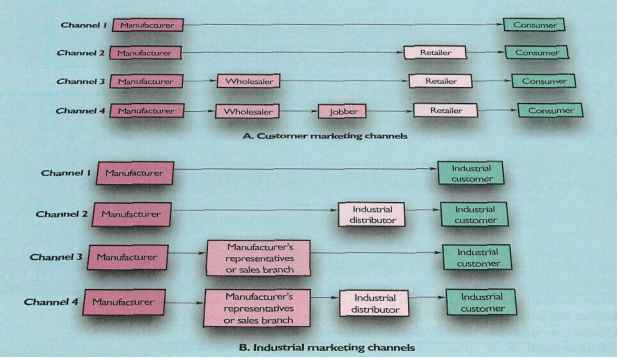Types of Marketing Intermediaries
Distribution channels can be described by the number of channel levels involved. Each layer of marketing intermediaries that performs some work in bringing the product and its ownership closer to the final buyer is a channel level. Because the producer and the final consumer both perform some work, they are part of every channel. The nitmher of intermediary levels indicates the length of a channel. The image shows several consumer distribution channels of different lengths.

Direct Marketing Channel
Called a direct-marketing channel, has no intermediary levels. It consists of a manufacturer selling directly to consumers. For example, Dell Computer sells personal computers by mail-order rather than through dealers or retailers, and Tupperware uses home parties to sell its kitchen products. Direct sales of consumer goods in some European countries have enjoyed record growth in recent years, and this is one sector of the retail economy, for example, that has survived the recession.
Indirect Marketing Channel
The remaining channels in are indirect-marketing channels. Channel 2 contains one intermediary level. In consumer markets, this level is typically a retailer. For example, the makers of televisions, cameras, furniture, major appliances and many other products sell their goods directly to large retailers, which then sell the goods to final consumers. Channel 1 contains two intermediary levels, a wholesaler and retailer. This channel is often used by channel level A layer of in intermediaries performs some isxirk in bringing the product and its ownership closer to the final buyer.

Consumer and industrial marketing channels
Channel 4 contains three intermediary levels. In the meat-packing industry, for example, jobbers usually come between wholesalers and retailers. The jobber buys from wholesalers and sells to smaller retailers, which generally are not served by larger wholesalers. Distribution channels with even more levels are sometimes found, but less often. From the producer's point of view, a greater number of levels means less eontrol and greater channel complexity.
The Image shows some common industrial or business distribution channels. The business marketer can use its own sales lorce to sell directly to business customers. It can also sell to industrial distributors, which in turn sell to business customers. It can sell through manufacturers' representatives or its own sales branches to business customers, or it can use these representatives and branches to sell through industrial distributors. Thus business markets commonly include multilevel distribution channels.
In summary, channel institutions play an important role in making products or services available to customers. Between them, channel members ensure the transfer of several entities; the physical product, ownership, money or payment, information and promotion. These transfers can make even channels with only one or few levels very complex. The types of intermediary channel will be discussed in greater detail in a later section.
Continue reading here: Channel Behaviour and Organization
Was this article helpful?
Readers' Questions
-
shukornia1 year ago
- Reply
-
veikko1 year ago
- Reply
-
nebyat1 year ago
- Reply
-
vanna1 year ago
- Reply
-
matthias schmid1 year ago
- Reply
-
YONATAN1 year ago
- Reply
-
Saku Sj1 year ago
- Reply
-
Almaz1 year ago
- Reply
-
sophie ostermann1 year ago
- Reply